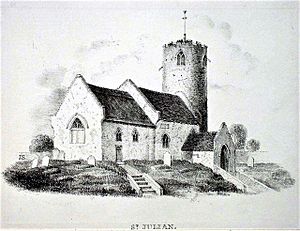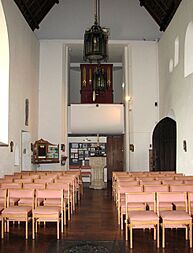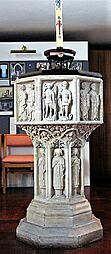St Julian's, Norwich facts for kids
Quick facts for kids St Julian |
|
|---|---|
| St Julian's Church, Norwich | |
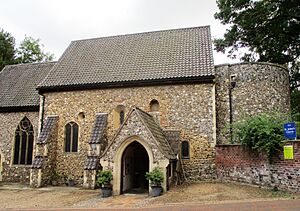
View from north
|
|
| 52°37′29.4″N 1°18′02.4″E / 52.624833°N 1.300667°E | |
| Location | Norwich, Norfolk |
| Country | England |
| Denomination | Church of England |
| Website | stjohnstimberhill.org |
| History | |
| Founded | 11th century |
| Dedication | Julian of Le Mans, or possibly Julian the Hospitaller |
| Events | Destroyed by bombing in 1942; rebuilt 1953. |
| Architecture | |
| Functional status | Active |
| Heritage designation | Grade I listed |
| Specifications | |
| Bells | 1 |
| Administration | |
| Parish | Norwich, St John the Baptist, Timberhill with Norwich St Julian |
| Deanery | Norwich East |
| Archdeaconry | Norwich |
| Diocese | Norwich |
| Province | Canterbury |
St Julian's Church is a very old church in Norwich, England. It is a Grade I listed building, which means it is very important historically. The church is part of the Church of England.
A famous anchoress named Julian of Norwich lived in a small room attached to this church during the Middle Ages. This room was later taken down in the 1530s.
Over time, the church started to fall apart because there wasn't enough money for repairs. One side of the building even collapsed in 1845. It was fixed up after that. The church's tower was also repaired in 1934.
Sadly, in June 1942, St Julian's was hit by a bomb during World War II. It was one of four churches destroyed in Norwich during the war. However, St Julian's was the only one that was rebuilt. It reopened in 1953. The church's old bell, which was damaged in the bombing, was put back up in 1992.
Today, the church is made of flint with stone and brick parts. It has a pantile roof. It's a small church with a main area called a nave, a chancel, and a round tower. Some parts, like the south chapel and porch, were added in the 1950s. The baptismal font was moved here from another church in 1977. St Julian's also has an old pipe organ from 1860.
Contents
About St Julian's Church
St Julian's is one of the churches in the parish of St John the Baptist, Timberhill, in Norwich. It belongs to the Diocese of Norwich. As of January 2023, the main priest for the parish is the Reverend Richard Stanton.
The church is open every day for people who want to pray or visit. A church service called Mass is held on Sunday mornings.
The Church's Long History
Early Days and Medieval Times
An early church on this spot was destroyed in 1004 when the Vikings attacked Norwich. The medieval church we know today was built between the 11th and 12th centuries. For a while, from 1269 to 1305, the nearby church of St Edward King and Confessor joined with St Julian's.
It's not completely clear who the church was first named after. It might have been Julian the Hospitaller or even a female saint, Juliana of Nicomedia. In 1135, Stephen, King of England placed the church under the care of Carrow Abbey. The nuns from the abbey were in charge of appointing the priest and looking after the church.
In the mid-1300s, Norwich was a very important city. It had about 25,000 people, making it the second-largest city in medieval England after London. It was a wealthy city with many churches.
Julian of Norwich: A Famous Resident
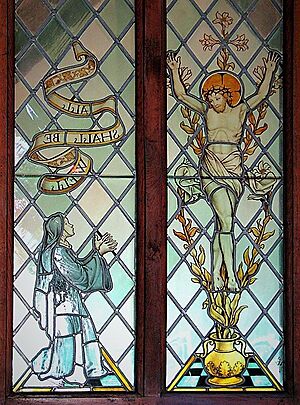
During the late Middle Ages, Norwich had many hermits and anchorites. These were people who chose to live alone for religious reasons. Julian of Norwich was a famous anchoress who lived in a small room, or cell, attached to St Julian's Church. This area was busy, close to the quays of the River Wensum.
Julian was born around 1342 or 1343. We don't know exactly when she died, but it was after 1416. Her name might have come from St Julian's Church, but Julian was also a common name for girls back then.
When Julian moved into her cell, she was cut off from the outside world. The door connecting her cell to the church was sealed. She had a small window to watch Mass and another to talk to visitors.
Julian is important because she was the first woman whose writings in English have survived. Her book, called Revelations of Divine Love, tells about 16 special visions she had after she became very ill.
Decline and Rebuilding Efforts
After the English Reformation, the abbey that looked after St Julian's was closed. For 45 years, no new priest was appointed to St Julian's. During this time, Julian's cell was torn down.
As merchants moved away from the area, St Julian's Church slowly started to fall apart. By 1827, much of the east window was blocked up. Services stopped, and the church was in very bad condition. Part of the chancel collapsed in 1845.
After the collapse, money was raised to fix the church. It was repaired, and the old wall paintings were covered up or destroyed. The church's tower was made shorter, and a new east window was put in. By 1860, the roof was covered with tiles instead of thatch. By the early 1900s, the tower was again in danger of falling, so it was repaired in 1934.
Destruction and Rebuilding in World War Two
St Julian's Church was almost completely destroyed during the Norwich Blitz in 1942. On June 27, German planes attacked Norwich with bombs. A bomb hit the church directly, destroying almost everything except the north wall.
After the war, people raised money to rebuild the church. It was the only church destroyed in Norwich during the war that was rebuilt. An architect named A. J. Chaplin redesigned it, and it reopened in 1953. A new chapel was built where Julian of Norwich's cell used to be. A doorway from another destroyed church, St Michael at Thorn, was used in the new building.
The church's bell was made in 1450. It has a Latin message that means "Hail the Lord, full of grace, be with you." This bell is one of the oldest in the city. It fell and was badly damaged when the church was bombed. After being fixed, it was put back in the church in 1992.
Church Architecture
St Julian's Church was given Grade I Listed status in 1954. This means it is a very important historic building. The church is built from flint with stone and brick details. It has a pantile roof. It includes a nave, a chancel, a round tower, a south chapel, and a vestry.
Parts of the original church still have some very old Anglo-Saxon windows. The building mostly dates back to the 11th and 12th centuries. Enough of the north wall survived to show three Anglo-Saxon windows, two of which are round.
The round tower was not rebuilt to its original height after the war. The south chapel and vestry were added in the 20th century. The porch was added when the church was rebuilt in the 1950s. The Norman doorway connecting the nave to the chapel came from St Michael at Thorn, another church destroyed in the 1942 bombing.
The Font
The church's baptismal font is octagonal, meaning it has eight sides. The original font was lost when the church was bombed. The current font was moved from All Saints' Church, Norwich in 1977. It has eight figures carved into it, including the Apostles, Saint Michael the Archangel, and Saint George.
The Organ
St Julian's has a pipe organ that was built in 1860 by Henry Jones of London. It was installed in the church in 1966. The organ was originally made for a house in the village of Abbess Roding in Essex. It was found in a warehouse and then rebuilt for the church.
Churchyard Discoveries
In 1906, some old stonework was found in the churchyard. People think it might have come from Julian of Norwich's destroyed cell.
Between 2014 and 2015, archaeological digs happened just east of the churchyard. They found medieval features, including graves. This work showed that St Julian's churchyard used to stretch further east, all the way to King Street. That part of the churchyard was built over by the 1600s.


